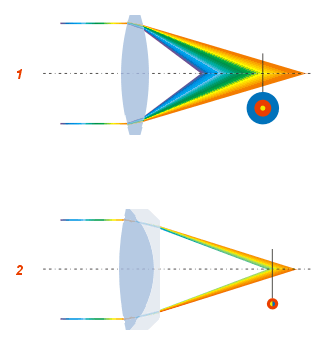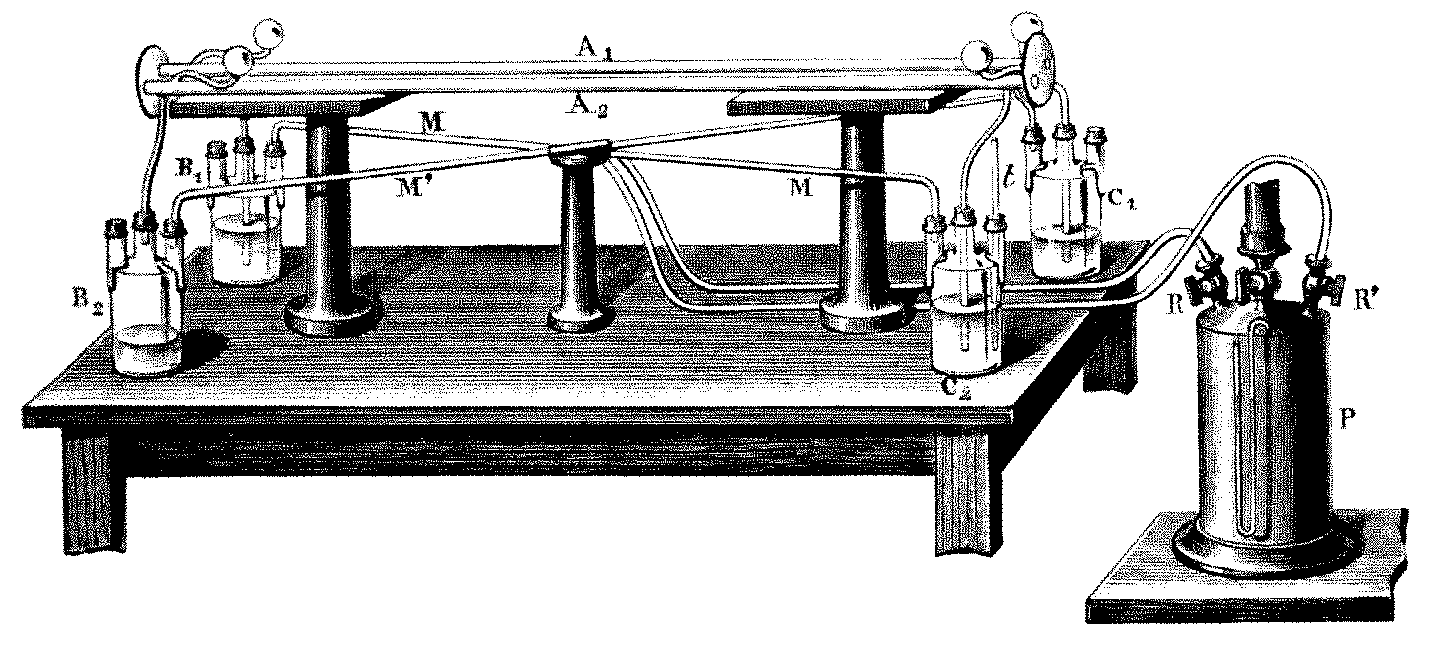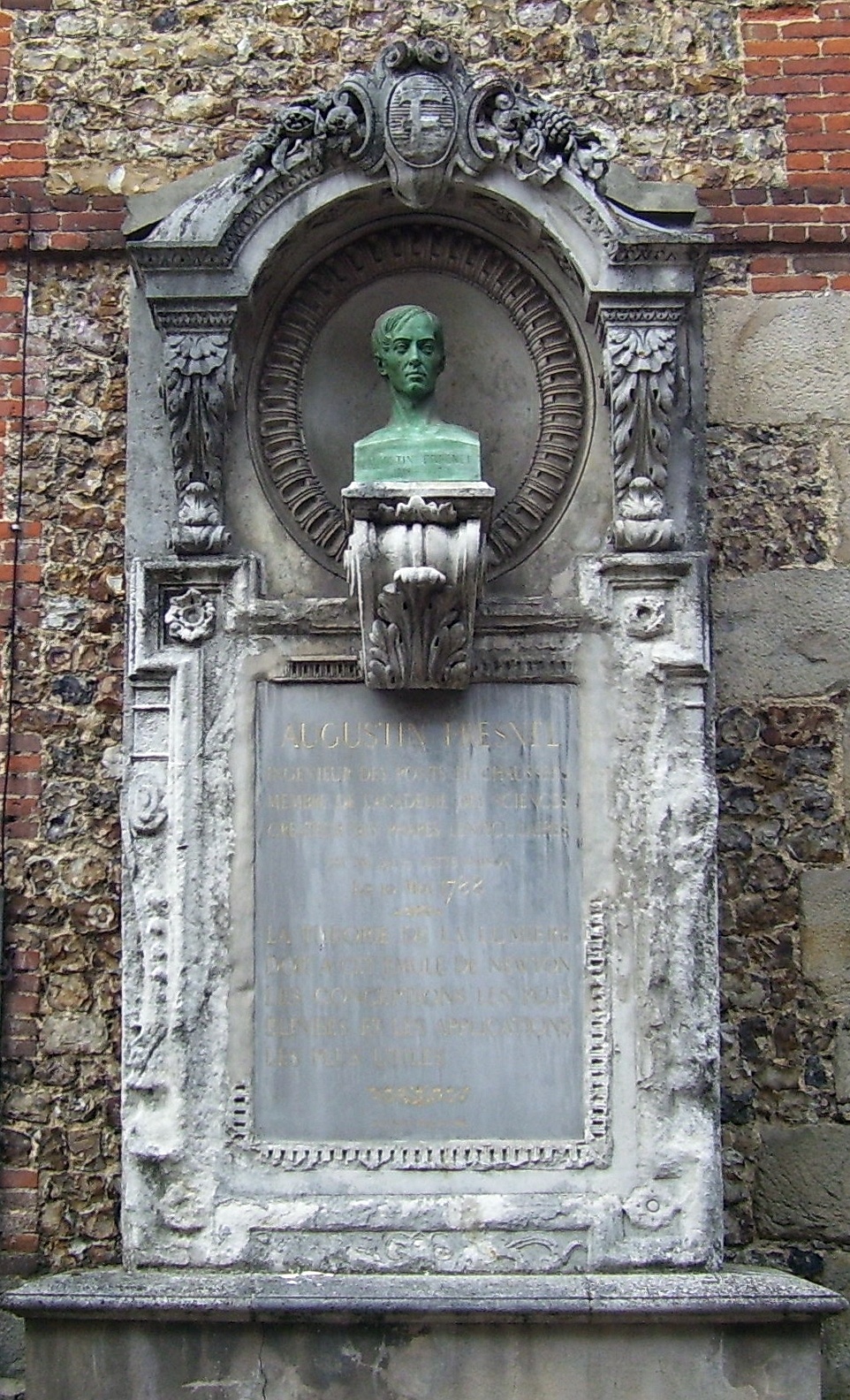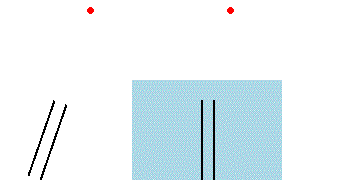|
Aberration Of Light
In astronomy, aberration (also referred to as astronomical aberration, stellar aberration, or velocity aberration) is a phenomenon where celestial objects exhibit an apparent motion about their true positions based on the velocity of the observer: It causes objects to appear to be displaced towards the observer's direction of motion. The change in angle is of the order of where is the speed of light and the velocity of the observer. In the case of "stellar" or "annual" aberration, the apparent position of a star to an observer on Earth varies periodically over the course of a year as the Earth's velocity changes as it revolves around the Sun, by a maximum angle of approximately 20 arcseconds in right ascension or declination. The term ''aberration'' has historically been used to refer to a number of related phenomena concerning the propagation of light in moving bodies. Aberration is distinct from parallax, which is a change in the apparent position of a relatively ne ... [...More Info...] [...Related Items...] OR: [Wikipedia] [Google] [Baidu] |
Optical Aberration
In optics, aberration is a property of optical systems, such as Lens (optics), lenses and mirrors, that causes the ''image'' created by the optical system to not be a faithful reproduction of the ''object'' being observed. Aberrations cause the image formed by a lens to be blurred, distorted in shape or have color fringing or other effects not seen in the object, with the nature of the distortion depending on the type of aberration. Aberration can be defined as a departure of the performance of an optical system from the predictions of paraxial optics. In an imaging system, it occurs when light from one point of an object does not converge into (or does not diverge from) a single point after transmission through the system. Aberrations occur because the simple paraxial theory is not a completely accurate model of the effect of an optical system on light, rather than due to flaws in the optical elements. An image-forming optical system with aberration will produce an image which i ... [...More Info...] [...Related Items...] OR: [Wikipedia] [Google] [Baidu] |
Electromagnetism
In physics, electromagnetism is an interaction that occurs between particles with electric charge via electromagnetic fields. The electromagnetic force is one of the four fundamental forces of nature. It is the dominant force in the interactions of atoms and molecules. Electromagnetism can be thought of as a combination of electrostatics and magnetism, which are distinct but closely intertwined phenomena. Electromagnetic forces occur between any two charged particles. Electric forces cause an attraction between particles with opposite charges and repulsion between particles with the same charge, while magnetism is an interaction that occurs between charged particles in relative motion. These two forces are described in terms of electromagnetic fields. Macroscopic charged objects are described in terms of Coulomb's law for electricity and Ampère's force law for magnetism; the Lorentz force describes microscopic charged particles. The electromagnetic force is responsible for ma ... [...More Info...] [...Related Items...] OR: [Wikipedia] [Google] [Baidu] |
Fizeau Experiment
The Fizeau experiment was carried out by Hippolyte Fizeau in 1851 to measure the relative speeds of light in moving water. Fizeau used a special interferometer arrangement to measure the effect of movement of a medium upon the speed of light. According to the theories prevailing at the time, light traveling through a moving medium would be dragged along by the medium, so that the measured speed of the light would be a simple sum of its speed ''through'' the medium plus the speed ''of'' the medium. Fizeau indeed detected a dragging effect, but the magnitude of the effect that he observed was far lower than expected. When he repeated the experiment with air in place of water he observed no effect. His results seemingly supported the partial aether-drag hypothesis of Augustin-Jean Fresnel, a situation that was disconcerting to most physicists. Over half a century passed before a satisfactory explanation of Fizeau's unexpected measurement was developed with the advent of Albert Ein ... [...More Info...] [...Related Items...] OR: [Wikipedia] [Google] [Baidu] |
Michelson–Morley Experiment
The Michelson–Morley experiment was an attempt to measure the motion of the Earth relative to the luminiferous aether, a supposed medium permeating space that was thought to be the carrier of light waves. The experiment was performed between April and July 1887 by American physicists Albert A. Michelson and Edward W. Morley at what is now Case Western Reserve University in Cleveland, Ohio, and published in November of the same year. The experiment compared the speed of light in perpendicular directions in an attempt to detect the relative motion of matter, including their laboratory, through the luminiferous aether, or "aether wind" as it was sometimes called. The result was negative, in that Michelson and Morley found no significant difference between the speed of light in the direction of movement through the presumed aether, and the speed at right angles. This result is generally considered to be the first strong evidence against some aether theories, as well as initiating ... [...More Info...] [...Related Items...] OR: [Wikipedia] [Google] [Baidu] |
Moving Magnet And Conductor Problem
The moving magnet and conductor problem is a famous thought experiment, originating in the 19th century, concerning the intersection of classical electromagnetism and special relativity. In it, the current in a conductor moving with constant velocity, ''v'', with respect to a magnet is calculated in the frame of reference of the magnet and in the frame of reference of the conductor. The observable quantity in the experiment, the current, is the same in either case, in accordance with the basic ''principle of relativity'', which states: "Only ''relative'' motion is observable; there is no absolute standard of rest". However, according to Maxwell's equations, the charges in the conductor experience a magnetic force in the frame of the magnet and an electric force in the frame of the conductor. The same phenomenon would seem to have two different descriptions depending on the frame of reference of the observer. This problem, along with the Fizeau experiment, the aberration of ligh ... [...More Info...] [...Related Items...] OR: [Wikipedia] [Google] [Baidu] |
Maxwell's Equations
Maxwell's equations, or Maxwell–Heaviside equations, are a set of coupled partial differential equations that, together with the Lorentz force law, form the foundation of classical electromagnetism, classical optics, Electrical network, electric and Magnetic circuit, magnetic circuits. The equations provide a mathematical model for electric, optical, and radio technologies, such as power generation, electric motors, wireless communication, lenses, radar, etc. They describe how electric field, electric and magnetic fields are generated by electric charge, charges, electric current, currents, and changes of the fields.''Electric'' and ''magnetic'' fields, according to the theory of relativity, are the components of a single electromagnetic field. The equations are named after the physicist and mathematician James Clerk Maxwell, who, in 1861 and 1862, published an early form of the equations that included the Lorentz force law. Maxwell first used the equations to propose that ligh ... [...More Info...] [...Related Items...] OR: [Wikipedia] [Google] [Baidu] |
Lorentz Ether Theory
What is now often called Lorentz ether theory (LET) has its roots in Hendrik Lorentz's "theory of electrons", which marked the end of the development of the classical aether theories at the end of the 19th and at the beginning of the 20th century. Lorentz's initial theory was created between 1892 and 1895 and was based on removing assumptions about aether motion. It explained the failure of the negative aether drift experiments to first order in ''v''/''c'' by introducing an auxiliary variable called "local time" for connecting systems at rest and in motion in the aether. In addition, the negative result of the Michelson–Morley experiment led to the introduction of the hypothesis of length contraction in 1892. However, other experiments also produced negative results and (guided by Henri Poincaré's principle of relativity) Lorentz tried in 1899 and 1904 to expand his theory to all orders in ''v''/''c'' by introducing the Lorentz transformation. In addition, he assumed that non-el ... [...More Info...] [...Related Items...] OR: [Wikipedia] [Google] [Baidu] |
Hendrik Lorentz
Hendrik Antoon Lorentz ( ; ; 18 July 1853 – 4 February 1928) was a Dutch theoretical physicist who shared the 1902 Nobel Prize in Physics with Pieter Zeeman for their discovery and theoretical explanation of the Zeeman effect. He derived the Lorentz transformation of the special theory of relativity, as well as the Lorentz force, which describes the combined electric and magnetic forces acting on a charged particle in an electromagnetic field. Lorentz was also responsible for the Lorentz oscillator model, a classical model used to describe the anomalous dispersion observed in dielectric materials when the driving frequency of the electric field was near the resonant frequency of the material, resulting in abnormal refractive indices. According to the biography published by the Nobel Foundation, "It may well be said that Lorentz was regarded by all theoretical physicists as the world's leading spirit, who completed what was left unfinished by his predecessors and prepar ... [...More Info...] [...Related Items...] OR: [Wikipedia] [Google] [Baidu] |
George Gabriel Stokes
Sir George Gabriel Stokes, 1st Baronet, (; 13 August 1819 – 1 February 1903) was an Irish mathematician and physicist. Born in County Sligo, Ireland, Stokes spent his entire career at the University of Cambridge, where he served as the Lucasian Professor of Mathematics for 54 years, from 1849 until his death in 1903, the longest tenure held by the Lucasian Professor. As a physicist, Stokes made seminal contributions to fluid mechanics, including the Navier–Stokes equations; and to physical optics, with notable works on Polarization (waves), polarisation and fluorescence. As a mathematician, he popularised "Stokes' theorem" in vector calculus and contributed to the theory of asymptotic expansions. Stokes, along with Felix Hoppe-Seyler, first demonstrated the oxygen transport function of haemoglobin, and showed colour changes produced by the aeration of haemoglobin solutions. Stokes was made a baronet by the British monarch in 1889. In 1893 he received the Royal Society's Copl ... [...More Info...] [...Related Items...] OR: [Wikipedia] [Google] [Baidu] |
Augustin-Jean Fresnel
Augustin-Jean Fresnel (10 May 1788 – 14 July 1827) was a French civil engineer and physicist whose research in optics led to the almost unanimous acceptance of the wave theory of light, excluding any remnant of Isaac Newton, Newton's corpuscular theory of light, corpuscular theory, from the late 1830s until the end of the 19th century. He is perhaps better known for inventing the Catadioptric system, catadioptric (reflective/refractive) Fresnel lens and for pioneering the use of "stepped" lenses to extend the visibility of lighthouses, saving countless lives at sea. The simpler Dioptrics, dioptric (purely refractive) stepped lens, first proposed by Georges-Louis Leclerc, Comte de Buffon, Count Buffon and independently reinvented by Fresnel, is used in screen magnifying glass, magnifiers and in condenser lenses for overhead projectors. By expressing Christiaan Huygens, Huygens's principle of secondary waves and Thomas Young (scientist), Young's principle of interference ... [...More Info...] [...Related Items...] OR: [Wikipedia] [Google] [Baidu] |
Aether Drag Hypothesis
In the 19th century, the theory of the luminiferous aether as the hypothetical Transmission medium, medium for the propagation of light waves was widely discussed. The aether hypothesis arose because physicists of that era could not conceive of light waves propagating without a physical medium in which to do so. When experiments failed to detect the hypothesized luminiferous aether, physicists conceived explanations for the experiments' failure which preserved the hypothetical aether's existence. The aether drag hypothesis proposed that the luminiferous aether is dragged by or entrained within moving matter. According to one version of this hypothesis, no relative motion exists between Earth and aether. According to another version, the Earth does move relative to the aether and the measured speed of light should depend on the speed of this motion ("aether wind"), which should be measurable by instruments at rest on Earth's surface. In 1818, Augustin-Jean Fresnel proposed that the a ... [...More Info...] [...Related Items...] OR: [Wikipedia] [Google] [Baidu] |
Classical Physics
Classical physics refers to physics theories that are non-quantum or both non-quantum and non-relativistic, depending on the context. In historical discussions, ''classical physics'' refers to pre-1900 physics, while '' modern physics'' refers to post-1900 physics, which incorporates elements of quantum mechanics and the theory of relativity. However, relativity is based on classical field theory rather than quantum field theory, and is often categorized as a part of "classical physics". Overview ''Classical theory'' has at least two distinct meanings in physics. It can include all those areas of physics that do not make use of quantum mechanics, which includes classical mechanics (using any of the Newtonian, Lagrangian, or Hamiltonian formulations), as well as classical electrodynamics and relativity. Alternatively, the term can refer to theories that are neither quantum or relativistic. Depending on point of view, among the branches of theory sometimes included in c ... [...More Info...] [...Related Items...] OR: [Wikipedia] [Google] [Baidu] |








